WALNUT HUSKS
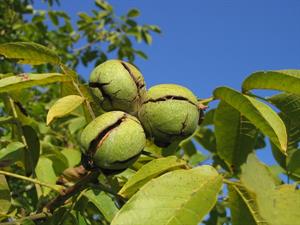
WALNUT HUSKS
Walnuts (genus Juglans) are plants in the family Juglandaceae. They are deciduous trees, 10 - 40 metres tall (about 30-130 ft.).
The 21 species in the genus range across the north temperate Old World from southeast Europe east to Japan, and more widely in the New World from southeast Canada west to California and south to Argentina. The Latin name Juglans derives from Jovis glans, "Jupiter's acorn": figuratively, a nut fit for a god.
The word walnut derives from Old English wealhhnutu, literally "foreign nut", wealh mea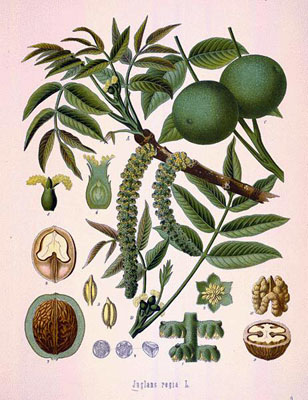 ning "foreign" (wealh is akin to the terms Welsh and Vlach; see *Walha and History of the term Vlach). The walnut was so called because it was introduced from Gaul and Italy. The previous Latin name for the walnut was nux Gallica, "Gallic nut".
ning "foreign" (wealh is akin to the terms Welsh and Vlach; see *Walha and History of the term Vlach). The walnut was so called because it was introduced from Gaul and Italy. The previous Latin name for the walnut was nux Gallica, "Gallic nut".
HISTORICAL NOTES
As far back as Roman times black cloth was produced by dyeing of fabric or skeins in dye baths of tannic acid and iron salts; including using black walnuts. It is mentioned in Pliny and there is evidence of it in the dyeworks at Pompeii. Walnut was also known as a dye during the Viking Age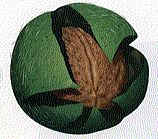 .
.
Dyeing black from a combination of tannic acid and iron salts was common in Roman times. Various plant materials were used including all portions of nut trees. The walnut (Juglans Nux Regia) was brought by the Roman to the European continent and England. The iron mordant was made from dissolving iron in vinegar. The fabric, if it was wool, was then dyed by the infectores and offectores.
Each step in wool production was handled by a separate company. As dyeing moves into the Middle Ages the Guilds take over the various steps of processing various fabrics. In Germany there is even a specific group for dyeing black called the Schwartzfarber. This group is less prestigious than one that dyed colors .
During the Viki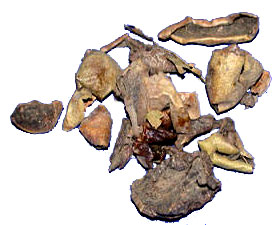 ng Age there is some evidence of dyeing with walnut shells. In addition, there are a couple pieces “that were intentionally dyed very dark brownish-black with walnut shells and iron (Hagg 1984, 289).” Both Brunello and Rogers comment that while there were naturally produced dyes they were not used in commercial production of cloth. Brunello further comments that this may have been due to the preference for brighter colors than those produced by natural tannic acids.
ng Age there is some evidence of dyeing with walnut shells. In addition, there are a couple pieces “that were intentionally dyed very dark brownish-black with walnut shells and iron (Hagg 1984, 289).” Both Brunello and Rogers comment that while there were naturally produced dyes they were not used in commercial production of cloth. Brunello further comments that this may have been due to the preference for brighter colors than those produced by natural tannic acids.
The Innsbruck Manuscript was written around 1330 and contains a number of German recipes. The manuscript notes using both alum and iron as mordants. One recipe specifically refers to using nuts and it has been thought that the reference was to walnuts:
"Nim grün nusschaln vnd stozz die vnder einander vnd lazze das siben tag vaulen in einem hevelein vnd da mit verb schwarcz varb." (Take green nutshells and grind them together and let them rot seven days in a (stoneware?) pot, and therewith make a black dye.)
In the mid-16th C., with the advent of the printing press, there are a profusion of books published on diverse topics. One is Giovanventura Rosetti’s Plictho: Instructions in the Art of the Dyers which Teaches the Dyeing of Woolen Cloths, Linens, Cottons, and Silk by the Great Art as Well as by the Common. It contains 108 recipes for dyes of which 20 are for black. A number of these are tannins mixed with iron salts. Included are several that use various parts of nut trees.
DYE
|
Mordant |
Color |
|
Walnut husks+Alum |
rich golden browns, mahogany brown |
|
Walnut husks+Copper |
deep chocolate brown, dark brown |
|
Walnut husks+Iron |
black |
|
Walnut husks+Tin |
rich brown with somewhat honey tones |
|
Walnut husks (No mordant) |
Dark brown |
Ground Walnut Husks 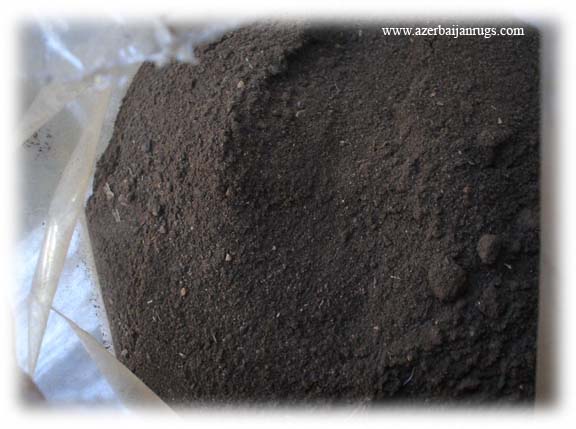
DYEING RECIPES
Brown Dyeing with Walnut Bark
Method
-
Soak the pulverised walnut bark overnight in 20 times its weight of water
-
Mordant the yarn with 3% potassium dichromate and 1% sulphuric acid
-
Boil the soaked walnut bark for at least half an hour then pass it through a sieve
-
Add the walnut bark concoction to the dye-bath
-
Slowly heat the dye-bath to 60°C
-
Add the damp, mordanted yarn to the dye bath
-
Take 1 hour to bring the dye-bath to boil
-
Boil for 1 hour
-
Allow to cool, wash, rinse and hang to dry
You can use the remaining dye-bath to make lighter shades
Brown Dyeing with Walnut Husk
This dye method was originally intended for using on woven baskets and specified Black Walnuts, but is perfectly applicable to the English (Persian) Walnut as well.
Method
-
Gather walnuts from the ground. Choose nuts still in the green husk.
-
Remove the nuts (optional) and put the husks into an old pillowcase.
-
Tie the pillowcase tightly shut with a piece of rope.
-
Place the husk-filled pillowcase into a large plastic rubbish bin.
-
Allow the rope to drape over the edge of the can for later retrieval of the husks.
-
Fill the container with hot water and cover
-
Allow to steep for several days until the dye achieves the depth of color you want.
-
Strain any solids out of the dye.
-
Dye can be decanted into containers and frozen to keep for later use.
-
Add a small amount of white vinegar to the dye to reduce the possibility of mold.
-
Wet your materials and immerse them in the dye until they reach the color you desire.
-
Dye can be painted or sprayed onto finished baskets.

